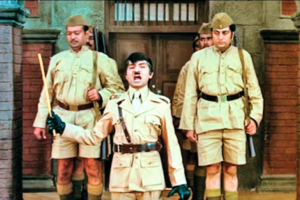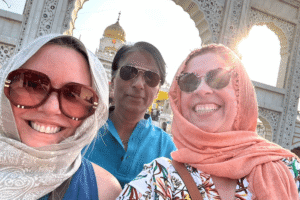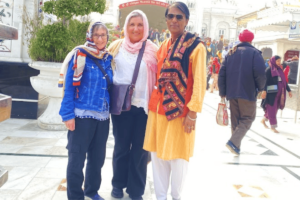Ajmeri Gate Delhi History – In the Footsteps of Sufi Saints I came from the United States of America for a business trip in Gurugram. After a week of meetings, malls, and fine dining, I felt something missing. I had seen the glass towers and the modern India everyone talks about, but I wanted to see the heartbeat of Delhi – the lanes, the smells, the colors, the stories.
One evening, while sipping coffee in my hotel lobby, I started browsing online and stumbled upon an “Old Delhi Heritage Walk.” Something about the description felt magnetic – narrow lanes, Mughal-era gates, spice markets, and centuries-old stories. Without thinking twice, I booked the tour.
The next morning, a charming man came to pick me up from my hotel. He introduced himself as Harry. Honestly, at first, I thought Harry would be an elderly historian, but he was young, energetic, and spoke about Delhi as if it were his own living, breathing family member. Our first stop was Ajmeri Gate Delhi.
Ajmeri Gate Delhi History – From Royal Entry to Colonial Encounters
Harry then shared a fascinating chapter of Ajmeri Gate Delhi History during the British era. After the 1857 uprising, the gate witnessed fierce battles as Indian sepoys tried to reclaim the city from the British. The scars of that time are still etched into its walls – faint, but undeniable.
Post-rebellion, the British altered parts of the walled city, but Ajmeri Gate survived. It became a busy point of entry for traders and common people. The road beyond the gate led to the bustling markets of Chawri Bazaar and beyond, connecting the city’s trade to the western provinces.
We stood at the very spot where, over a century and a half ago, freedom fighters once stood. The air felt heavy with history, yet strangely empowering.
Ajmeri Gate Delhi History – The Markets, the Life, the Chaos
Moving past the gate, Harry took me into a swirl of colors and sounds. Though much of Ajmeri Gate Delhi History is about its strategic and political role, it is equally about the everyday life it guarded. The streets were alive – vendors selling spicy chaats, rickshaw pullers weaving through crowds, and the aroma of freshly fried samosas blending with incense from roadside shrines.
Harry pointed out that many traders still use routes that have existed for centuries. Silk, spices, brassware – they’ve all passed through Ajmeri Gate at one time or another. It’s a living reminder that history is not locked in books or monuments; it walks among us every day.
Ajmeri Gate Delhi History – Architecture that Speaks
I took a moment to really observe the architecture. Ajmeri Gate Delhi History is visible in its robust Mughal design – the pointed arch, the flanking bastions, and the deep-set niches that once housed lamps to guide travelers at night. The sandstone had weathered into a warm, earthy tone, yet it still exuded dignity.
Harry mentioned that the gate had once been connected to a strong fortification wall enclosing the entire city. While much of the wall has vanished due to urban expansion, Ajmeri Gate remains as a silent witness to the city’s evolution from Mughal grandeur to colonial rule, and now, to modern chaos.
Ajmeri Gate Delhi History – Stories That Stay With You
Harry has a gift for storytelling. As we stood there, he told me about a Sufi saint who used to bless travelers leaving the city through Ajmeri Gate on their way to the shrine of Khwaja Moinuddin Chishti in Ajmer. Pilgrims believed that starting their journey from this gate brought them spiritual protection.
There’s something profoundly moving about learning that Ajmeri Gate Delhi History isn’t just about wars and politics; it’s also about faith, blessings, and human connection. That mix of the grand and the intimate is what makes Old Delhi unforgettable. Ajmeri Gate Delhi History – Why You Should Visit
If you truly want to understand Delhi, start with its gates. And if you start with Ajmeri Gate, you’ll understand the city’s soul. Ajmeri Gate Delhi History is a perfect introduction – it’s where architecture, politics, trade, and faith intersect.
For me, this wasn’t just a stop on a sightseeing tour. It was the moment I felt Delhi open its heart to me. Standing there, I realized that the “real Delhi” isn’t just in its monuments or markets, but in the way history and life flow together seamlessly.
Final Thoughts – A Walk Through Time
By the time we left Ajmeri Gate, I felt richer – not in the material sense, but in experience. My business trip had brought me to India, but Ajmeri Gate Delhi History made me feel connected to its past in a way I hadn’t expected.
Harry led me deeper into Old Delhi after that – to spice markets, hidden temples, and narrow alleys filled with stories – but Ajmeri Gate was the place where my journey truly began.
If you ever visit Delhi, take an Old Delhi Heritage Walk. And when you stand before Ajmeri Gate, remember that you’re not just looking at a monument – you’re standing in the footprints of emperors, traders, pilgrims, and freedom fighters. That’s the magic of Ajmeri Gate Delhi History – it’s not just about the past; it’s about how the past still walks beside you.







